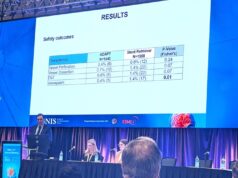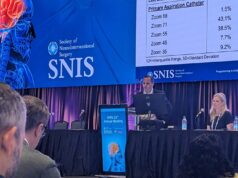This advertorial, intended only for audiences outside the USA, is sponsored by Penumbra.

Recently, at the 2024 BRAIN conference (2–4 December, London, UK), David Volders (University of Toronto, Toronto, Canada) sat down with NeuroNews to discuss mechanical thrombectomy devices that have had a profound, positive impact on his ischaemic stroke practice, as well as touching on a number of potential paradigm shifts—present and future—in aspiration thrombectomy.
Throughout 2024, in an effort to complete its stroke care portfolio, Penumbra launched a total of five new products in Europe: the RED 43, RED 72 with SENDit technology and RED 78 reperfusion catheters, and also the BMX81 and BMX96 neurovascular access catheters. And, in Volders’ view, “for several reasons”, BMX96 can be seen as a game-changing technology.
“First of all, it really offers a lot of support, which is very helpful in complicated stroke cases where access is an issue,” he says. “Additionally, it tracks really well and that helps with [vessel] tortuosity, for example. On top of that, the inner diameter is also a 096—which is the largest inner diameter of all of [Penumbra’s] guide catheters—and that allows you to go up with bigger aspiration catheters like the recently launched RED 78. And, finally, it really allows you to go high into the petrous ICA [internal carotid artery] without being too traumatic during thrombectomy procedures. So, there are several aspects that allow you to have major benefits.”
However, while BMX96 may have had a profound impact on his practice, Volders is also quick to highlight the benefits brought about by the newly introduced RED 72 catheter—and, more specifically, the advantages enabled by Penumbra’s SENDit technology.
“The first thing to note is that SENDit is very easy to prepare,” he comments. “It all comes prepackaged, with an easy flush, and you just have to put in a 014 wire and you’re good to go. We all know that, in stroke, ‘time is brain’; having to prepare a separate microcatheter and then bring it into the aspiration catheter—those are additional steps and they take time that could be spent doing other things.”
Volders also feels that SENDit is a “very useful tool” when it comes to, for example, the ophthalmic artery and the particularly apparent ‘ledge effect’ that is often produced when using other aspiration catheters and microcatheters in this location. The effect “disappears” when utilising SENDit technology, he adds, ensuring RED 72 tracks “really nicely” past the ophthalmic artery.
“That’s where a lot of people get stuck when they’re doing aspiration [thrombectomy], and have to revert to using stents,” Volders posits. “Having a tool like SENDit really is another gamechanger.”
Evolution of aspiration
In addition to the many technologies Penumbra has introduced into the neurovascular space in recent times, another ongoing and potentially momentous development in stroke interventions is the shift away from balloon guide catheter (BGC) usage.
Volders’ view is that a key driver of this is the enhanced understanding clinicians now have regarding the physics of aspiration.
“Previously—10–15 years ago—people were thinking aspiration is just about a pump pulling in the clot,” he explains. “Now, they appreciate that it’s much more than that. Having systolic pressure that pushes the clot, and not just the pump pulling it, is actually something that’s very important. That is why I believe that it’s more helpful to not use a BGC—by taking away that systolic pressure, it’s basically working against you in getting a successful first-pass effect.”
Working alongside a handful of his colleagues in Canada, Volders has attempted to introduce a standardised approach to direct, aspiration-only thrombectomy, describing and summarising initial cases utilising the ‘CANADAPT’ technique via a 2024 publication in the journal Interventional Neuroradiology. Based on single-centre, prospective cohort data from 22 consecutive patients treated for large/medium-vessel ischaemic stroke, Volders et al conclude that CANADAPT demonstrated safety, efficiency and efficacy, with initial indications that the technique could be linked to shorter median procedure times and lower per-procedure costs compared to approaches involving stent retrievers plus aspiration.
Touching on this paper, Volders says that CANADAPT “standardises, but also optimises” first-pass effects with aspiration.
“It really uses that concept of both the pull of the pump and the push of the systolic pressure,” he adds.
“Previously, people were thinking aspiration is just about a pump pulling in the clot. Now, they appreciate that it’s much more than that.”
Another factor that is important to consider when seeking improved first-pass effect and overall thrombectomy success rates, according to Volders, is appropriate catheter sizing relative to the target vessel.
“I always like to say that one size does not fit all,” he avers, advising his peers to select an aspiration catheter size that occupies roughly 70–80% of the vessel’s lumen. “What that does is actually allow systolic blood pressure to still flow around and beyond the clot—and, when you pull back, you are going to see an increase in your first-pass effect.
“Imagine you have a catheter that’s too large for the vessel. First of all, you’re occlusive, and you don’t get that benefit of having the systolic blood pressure. But, on top of that, you run the risk of causing damage to the vessel—for example, with [vaso]spasm—and that’s something that might also negatively affect your outcome. The right sizing is very important and this, again, is something that’s new to people.
“Another thing that may also be important to mention is that every vessel is different, in everyone. One person’s M1 may have a different size to somebody else’s M1, so you can’t really say, ‘I use this aspiration catheter for that vessel’—you really have to tailor it.”
Positive outlook
The current slogan accompanying Penumbra’s ever-growing group of ischaemic stroke products in Europe is, ‘Versatile. Compatible. ADAPTable’. Outlining how this notion has translated into his own clinical practice, Volders highlights the diversity of the company’s present offering as being among its key strengths.
“What I like about Penumbra’s portfolio is that, for every different aspect of a stroke case, you can pivot,” he says. “If you have a difficult arch, you can use a SIM Select catheter. Or, you can choose BMX96, which offers you four times more support compared to a Neuron MAX. You can go pretty high into the ICA, you can look at the vessels, you can determine if you think it’s a large clot, and you can change your sizing to [reflect] that.
“You basically have such a wide range of choices in your aspiration catheters that, for every case, you can almost handpick the right tools to increase your first-pass success.”
Volders also touches on another area that he feels has genuine promise when it comes to improving thrombectomy outcomes for stroke patients: modulated aspiration, whereby computer-assisted technology is deployed in an attempt to reduce friction between the clot and reperfusion catheter, and ultimately facilitate more rapid and complete removal of blood clots from the brain.
Penumbra is currently playing a leading role in moving this part of the field forward, evaluating the safety and efficacy of its computer-assisted vacuum thrombectomy (CAVT) technology and Thunderbolt aspiration tubing via the THUNDER investigational device exemption (IDE) study. In October 2024, the company announced that it had completed enrolment of acute ischaemic stroke patients in this study.
“I do think the future lies with modulated aspiration,” Volders comments. “What happens is that the clot can be ingested into the aspiration catheter at the moment when the catheter is at the level of the clot. In our CANADAPT data, we found that there’s only a small percentage of clots that are actually ingested at this point—mainly because the systolic blood pressure is so minimal in this phase.
“I know Penumbra has worked very hard on this and is actually a pioneer in the field. So, I’m very excited to see what’s going to happen with the new Thunderbolt technology and I really believe that’s going to be another big gamechanger.”
David Volders is an associate professor at the University of Toronto, and an interventional and diagnostic neuroradiologist at Toronto Western Hospital, in Toronto, Canada.










